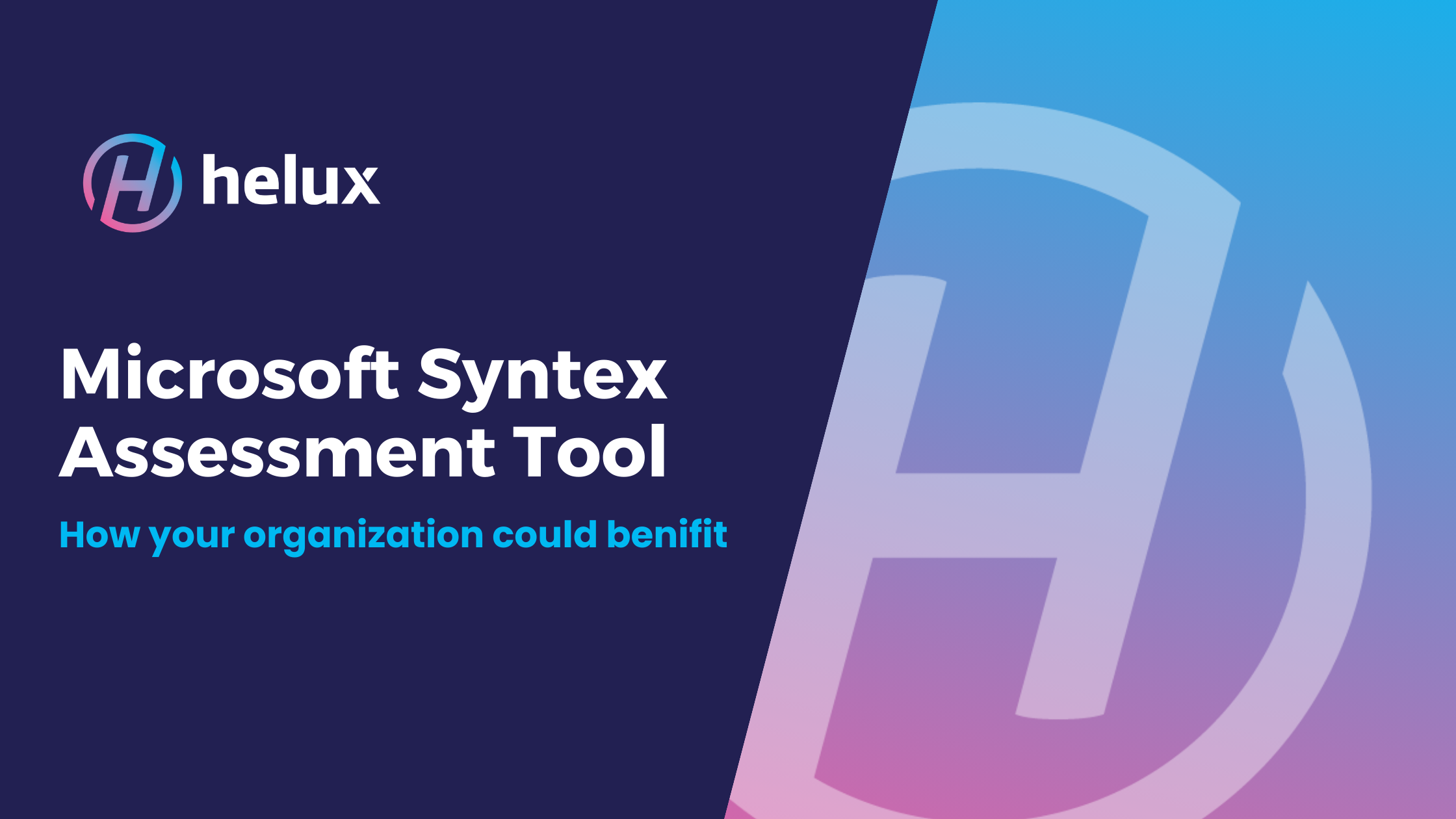Microsoft Syntex Tool
Microsoft Syntex (formerly called SharePoint Syntex) is a syntex-powered contracts management site designed for business use. The name change stems from the fact that Syntex has become much more than just a document classification tool. In fact, it is continuously updated with exciting new features including content assembly and eSignatures. You can check out the full Microsoft Syntex functionality here.
Following the launch of several new features at last year’s Microsoft Ignite conference for developers and IT professionals. The HELUX team took a deeper dive into the Microsoft Syntex Assessment tool to ensure we support our customers with the latest expertise and XYZ).
The assessment tool can be leveraged to determine which specific locations within your SharePoint environment would benefit most from the use of Syntex models to perform document auto-classification and automatic metadata tagging. The most important benefit of being able to classify documents in SharePoint is the ability to manage the document lifecycle from cradle to grave.
Could your organization benifit from Microsoft Syntex?
If your team doesn’t yet have Microsoft Syntex and is wondering if Syntex could be a useful addition to your content management strategy, we suggest running the Microsoft assessment. You’ll be given a compelling report with which to propose investment in this technology – ideal for discussions with your Board of Directors and other decision makers.
As an added benefit, the assessment tool provides a very useful overview of your information architecture in SharePoint. Unlike in the past, you would have to write PowerShell scripts to gain visibility into where content types and site columns are used. With the Microsoft Syntex Assessment tool, you’ll be able to access visual Power BI reports to obtain this data, saving you time and money.
Here is a quick step-by-step on how to run the assessment:
-
Download the Microsoft 365 Assessment tool from here.
-
Ensure your Azure AD application is set up properly as this is required for the assessment tool to run.
-
Begin an assessment. You can Find the full instructions and FAQs for running the assessment here.
-
Generate a Power BI report by using the ‘report’ action.
-
After running the assessment tool, several Power BI reports are generated:
Libraries with custom columns: Identifies libraries where Syntex can populate columns. Libraries with the most columns are great candidates for the Syntex model to have automatic tags.
Column Usage: Identifies patterns of columns usage. Columns used commonly across many libraries are great candidates for the Syntex model to have automatic tags.
Libraries with Custom Content Types: Identifies libraries using custom content types. Libraries with multiple content types can take advantage of Syntex models by automatically classifying a document and selecting the right content type.
Content Type Usage: Identifies patterns of content type usage. If you’ve developed a Syntex model for a content type, it might be possible to use the same model for other libraries associated with the same content type.
Libraries with retention labels: Identifies libraries where retention labels are used. Syntex models can also apply labels to documents that are classified. This report provides a listing of libraries where we can use a model to apply a label instead.
Library Size: This report indicates which libraries have the most documents and folders. If a large library has hundreds of folders, a Syntex model could be used to introduce metadata, and have it tagged automatically instead improving the searchability of these documents and reducing the need for folders.
Library Modernization Status: Identifies libraries which may need to be modernized. Classic libraries cannot take advantage of Syntex models, so it is better to convert these libraries to a modern experience as quickly as possible.
Prebuilt Model Candidates: Identifies libraries where names of content types suggest a prebuilt model could be applied. Microsoft provides two prebuilt models, Invoice and Receipt and plans to release more in the future.
Syntex Model Usage: Once you are up and running with Syntex Models, this report shows how many Syntex Models have been published and how many documents have been classified with models in the last 30 days. This will demonstrate how valuable Microsoft Syntex has been in automatically classifying and tagging your documents.
In short, this assessment tool is a vital part of the pre-planning process for Microsoft Syntex implementation. It provides crucial insights into what models you should create and where you should apply them. If your team is not yet ready to invest in Microsoft Syntex, you can use this tool to generate a comprehensive overview of your information architecture.
“AI is great but it’s better with a proper information architecture. This assessment tool provides organizations with a quick snapshot of their information architecture and identifies opportunities.” – Dan Taillefer, VP of Product, HELUX.
Once you have run the assessment and generated a Power BI report on your information architecture, a logical next step is to implement an intuitive web-based software that manages and streamlines your information architecture lifecycle. HELUX’s THEMIS IA allows you to design your information architecture from scratch or modify on-the-fly and publish directly to SharePoint Online.
Discover why leading companies trust HELUX’s information architecture and content migration tools to drive efficiency and productivity for their business – faster and better.

